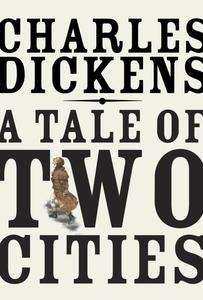A Tale of Two Cities

Editorial Vintage USA
Fecha de edición julio 1990
Idioma inglés
EAN 9780679729655
400 páginas
Libro
encuadernado en tapa blanda
Resumen del libro
Set against the backdrop of the French Revolution, A Tale of Two Cities is one of Charles Dickens's most popular and dramatic stories.
It begins on a muddy English road in an atmosphere charged with mystery and it ends in the Paris of the Revolution with one of the most famous acts of self-sacrifice in literature. In between lies one of Dickens's most exciting books-a historical novel that, generation after generation, has given readers access to the profound human dramas that lie behind cataclysmic social and political events. Famous for its vivid characters, including the courageous French nobleman Charles Darnay, the vengeful revolutionary Madame Defarge, and cynical Englishman Sydney Carton, who redeems his ill-spent life in a climactic moment at the guillotine ("It is a far, far better thing that I do, than I have ever done"), the novel is also a powerful study of crowd psychology and the dark emotions aroused by the Revolution, illuminated by Dickens's lively comedy.
With an Introduction by Simon Schama
Charles Dickens (1812-1870) was born in Portsmouth, England, and spent most of his life in London. When he was twelve, his father was sent to debtor's prison and he was forced to work in a boot polish factory, an experience that marked him for life. He became a passionate advocate of social reform and the most popular writer of the Victorian era.
Biografía del autor
p Charles Dickens nació en Portsmouth en 1812, aunque pasó la mayor parte de su infancia en Londres y Kent. No empieza a acudir al colegio hasta los nueve años. Tras el encarcelamiento de su padre por el impago de deudas, su familia se traslada a la cárcel, ya que la legislación de la época permitía que los familiares compartieran la celda del moroso. El joven Dickens se ve obligado entonces a trabajar como operario en una factoría de betún para zapatos bajo duras condiciones laborales. Con el dinero que ganaba pagaba su propio hospedaje y ayudaba a su familia. Tras una formación prácticamente autodidacta, consiguió un puesto como secretario de un abogado en 1827, y poco después se convirtió en cronista parlamentario. Gracias a este oficio pudo publicar en 1833 su primera obra, i Esbozos /i , bajo el seudónimo de Boz. En esta línea continuó publicando, hasta que su obra i Los papeles póstumos del Club Pickwick /i lo convirtió en un autor aclamado mundialmente. Que la mayoría de su obra fuera publicada en entregas periódicas le daría gran popularidad e influencia entre el público inglés. Viajó por Europa y Estados Unidos, donde era muy conocido, aunque tras la crítica que realiza del Nuevo Mundo en su novela i Martin Chuzzlewit /i , se ve rechazado por la sociedad norteamericana. Entre sus obras más célebres se encuentran i Oliver Twist /i , i Canción de Navidad /i y, sobre todo, i David Copperfield /i , del que vendería en poco tiempo más de 100.000 ejemplares y que resume de modo magistral sus penurias infantiles. En el ámbito personal disfrutó de un fecundo matrimonio que le aportó diez hijos pero que finalmente se vio perturbado por las relaciones extramatrimoniales que Dickens mantenía con una actriz de teatro. Hombre enérgico y comprometido, compaginó su extensa labor literaria con otros campos de la cultura tales como la dramaturgia y la edición (fue fundador del semanario Household Words, donde publicaría por entregas dos de sus obras más conocidas, i Casa desolada /i y i Tiempos difíciles /i ). Administró diversas asociaciones caritativas y luchó por conseguir reformas sociales que favorecieran a las clases obreras, así como por la abolición de la esclavitud en Estados Unidos. Murió en Gadshill Place, el 9 de junio de 1870, tras sufrir una apoplejía. Fue incinerado, y sus restos reposan en la Esquina de los Poetas de la Abadía de Westminster.<br>








